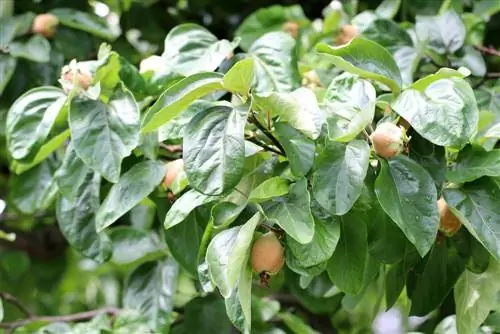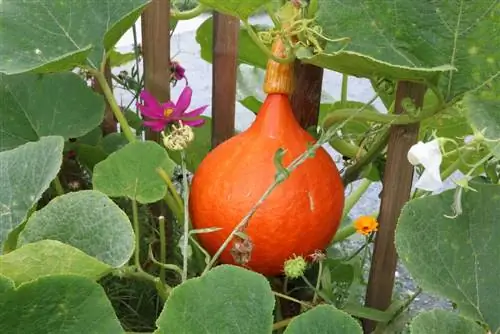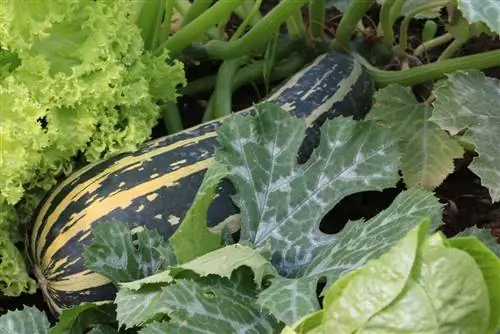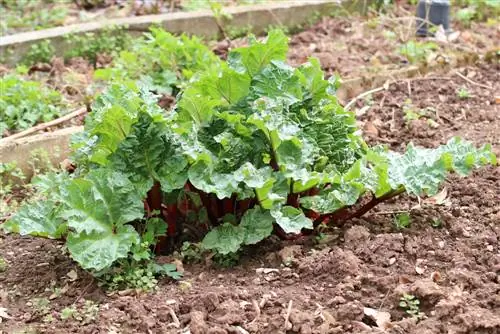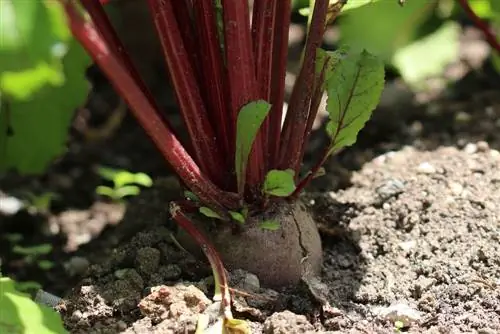- Author admin [email protected].
- Public 2023-12-17 03:39.
- Last modified 2025-01-24 12:45.
Winter apples like Boskop are harvested late in the year. Only then have they reached full maturity and can be kept for a long time. In contrast to summer or autumn apples, they only taste best after they have been stored for some time. The Boskop is a tart apple variety that is suitable for a variety of uses. In most cases it is also suitable for allergy sufferers.
More synonyms:
- Beautiful from Boskoop
- Boskoop
- Renette von Montfort
- Red Boskoop
Harvest time 2023
When it comes to winter apples, a distinction is made between ripeness for picking and ripeness for eating. The Boskop is ready for harvest between the end of September / beginning of October and the end of October. This depends on the exact location and the weather. In 2023, the Boskop harvest may fail altogether in some places due to last year's drought. You can check whether an apple is ready to harvest by looking at the tree. The apple is tilted slightly upwards and rotated. If it detaches from the branch, it is ready to harvest. Another way to determine how far the apples are is to cut an apple in half. If the seeds in the casing are brown, the apple is ripe.
Note:
Worm-eaten apples often become unripe and fall from the tree much earlier.
Technology
Equipment necessary for harvesting (depending on the height of the apple tree):
- small or larger ladder
- Apple or fruit picker with long handle
- one basket each for the fallen fruit and the spoiled apples
- Wooden boxes for the picked apples
- possibly a rolling collector to collect apples from the ground without having to touch them
- It makes sense to have several helpers for larger trees
Instructions
1. Before the Boskop harvest begins, the grass under the tree should be mowed. This can also be done before the harvest time so that the fallen fruit can be picked up regularly.
Note:
After autumn storms there are usually a lot of apples on the ground.
2. Before the fruit is taken from the tree, the fruit is first picked up from the ground. Fallen fruit is collected into baskets separately from rotten apples.
3. The easily accessible apples in the lower area are picked by hand. Any apple that falls to the ground belongs in the basket with the fallen fruit; it would not be suitable for storage because of the bruises. All remaining apples are placed in a single layer in wooden boxes.
4. After the lower area is harvested, the middle and upper areas are harvested with the apple picker. The collection bag usually fits several apples, but it still has to be emptied more often so that no apples fall into it. Using a fruit picker may take some practice.
5. If the length of the apple picker is no longer sufficient, a ladder is used. Exercise caution when adjusting the ladder. In any case, it must stand securely.
Store Boskop apples
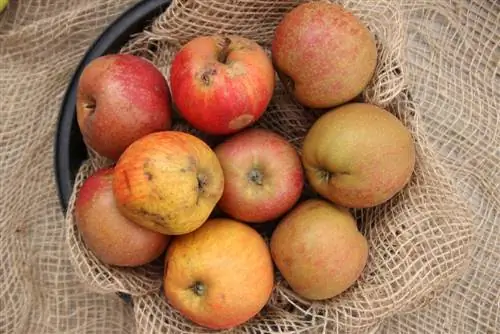
For winter apples, proper storage after harvesting is crucial so that they reach the ripeness for consumption in a he althy manner. At Boskop this is between December and March.
- Select the apples before storing them. Sort out all bruised, rotten, worm-eaten or otherwise damaged apples.
- The storage location should be cool, dark and never too dry. Otherwise the apples will shrivel too quickly. An old natural cellar is best. Frost-free garages and sheds can also be used as storage.
- There should be no other fruit or vegetables in storage, as apples excrete the ripening gas ethylene, which not only makes other fruits ripen faster, but also causes them to spoil more quickly.
- The storage apples are spread out in a single layer either in wooden crates or on wooden boards so that they do not touch each other. Newspaper is a good base for this.
- The apple storage should be ventilated regularly in frost-free weather. If the storage location is too dry, bowls with water can be set up.
- The apples should be checked at least once a week; all apples that show mold or rot are removed from storage.
- The apples will last until next spring in a cheap warehouse.
Processing the fallen fruit
While all rotten, moldy or otherwise spoiled fruits go into the compost, the fallen fruit should be processed quickly. If these are apples that have fallen from the tree a long time before the actual harvest, they are almost always worm-eaten. They can still be processed, simply cut out the relevant areas.
Processing options for Boskoop apple:
- Juice and then jelly
- Applesauce
- Jam or chutneys


